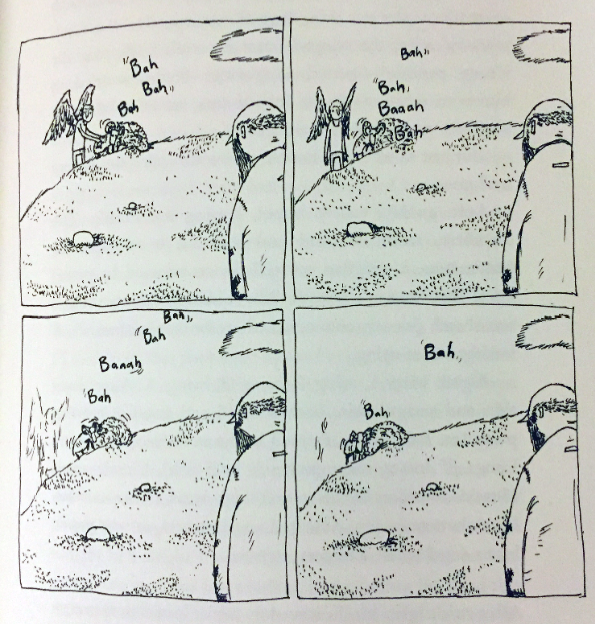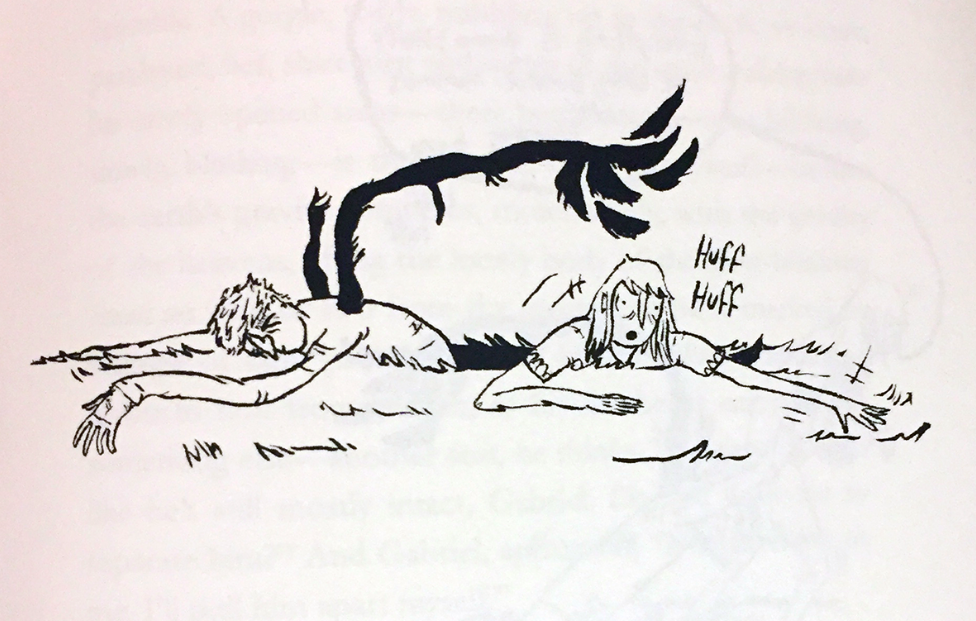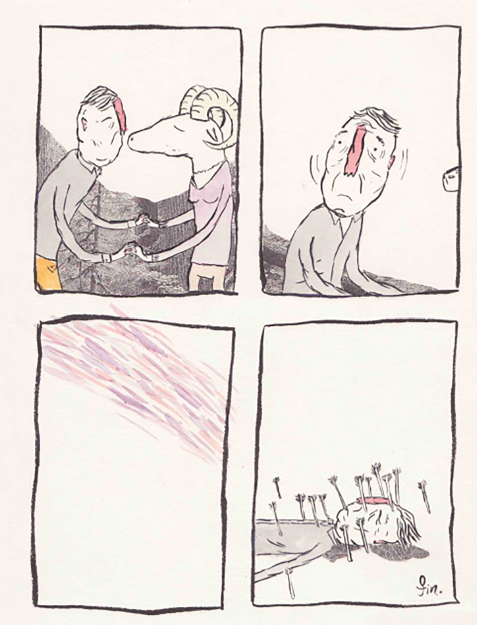The Short Story in the Age of Tumblr: On Nick Francis Potter’s “New Animals”
By Daniel WordenJanuary 12, 2017
:quality(75)/https%3A%2F%2Fdev.lareviewofbooks.org%2Fwp-content%2Fuploads%2F2017%2F01%2Fnewanimals.jpeg)
New Animals by Nick Francis Potter
The book’s stories are frequently set in a kind of mild dystopia, a world where characters still have access to various modern tools and equipment, but much of what we know has been stripped away. In the collection’s longest story, “Oops, Isaac,” Abraham actually kills his own son Isaac, because a new angel was late in bringing a sacrificial goat to the scene. What follows involves the punishment of the angel, the resurrection of Isaac, and marriage trouble between Abraham and Sarah. Angels are incompetent employees of a just-in-time delivery service, Abraham is a down-and-out farmer, Sarah is a preoccupied homemaker. The story’s setting both deflates the Biblical story to mundane proportions and estranges the piece’s contemporary diction with odd references, as if the reader is learning the acronyms of a workplace not their own. In the “official report” documenting the angel’s failure to intervene in Abraham’s sacrifice of Isaac, for example, the language of contemporary HR merges with Biblical violence:
The council will note ineptitude in terms of angelic monitoring and intervention regarding the subject, Mitchell IV, and his mismanagement of Abraham-and-Isaac with relation to Abraham’s commanded sacrifice of Isaac. The operation states specifically: pre-sacrifice arrival and audible announcement, “Psych!” […] it is inexcusable that the knife landed in flesh.
The comics pages that appear in the story detail, in nearly wordless panels, Abraham’s sacrifice of Isaac as they walk from their home to a hill. In these pages, Potter’s hand-drawn panel borders are expressive, yet minimal line work furthers the narrative’s tonal range, enhancing its meditative quality and its imbrication in our contemporary commodity clutter. As the perspective of the panels shift — from a focus on characters; to the home; to the larger terrain; to Isaac’s lingering, as if he anticipates what Abraham is planning to do — the world opens up to multiple interpretations. No one perspective is sovereign, and those of humans are not privileged. Instead, here and throughout Potter’s collection, people are displaced from the center of things. They exist in relation to, on par with, transforming into, and in this case undone by animals. In the last paneled sequence of comics in the story, Abraham sees the tardy angel and the ram only after slaying Isaac. The only speaking subject in this 12-page comics sequence is the ram, whose “bah bah” noises serve as a kind of emblem of isolation and tragedy realized by those who are simply human, trapped in civilization’s scripts.

From Nick Francis Potter, “Oops, Isaac.”
“Oops, Isaac” is a high point of New Animals not just because of its length but also due to its hybridity. This story blends illustration with text more completely than any other in the volume. Indeed, while many of the book’s prose stories involve familiar yet reduced settings, this story allows a kind of access to the texture of the world, to its crude materiality. A bundle of sticks, a hole in the ground, a piece of the wall chunked out by a thrown frying pan — these have a kind of brutal tactility that emblematize how New Animals’s world has become more rough around the edges and more prone to brutal acts. In “Oops, Isaac,” a second illustrated sequence involves Abraham’s wife, Sarah. She tries to find Isaac, and instead rescues the angel who was late, finding him in a hole, wings charred, after being punished for his tardiness. In single-page illustrations, Sarah struggles to get the angel out of the hole, and Potter’s ink work emphasizes the awkwardly charred wings, the stress and tiredness on both characters’ faces. The world of New Animals has been worn, roughed up, and exhausted, with redemption coming only through mending, not salvation.

Nick Francis Potter, “Oops, Isaac.”
In another comic from New Animals, “Arto’s Headspace,” a headless body is shot through with arrows, goes sailing, jams a head onto its neck, falls through a hole that removes the arrows from his body, severs a ram’s head, place the ram’s head on a female body, and is then shot through with arrows again. The comic concludes with Arto lying on the ground, pierced by the arrows. Perhaps the title character’s name, Arto, is a play on Artaud — hence the sadism of the piece. Or maybe — given that the Celtic word “artos” means “bear” — the name is meant to connote a proximity to animals. Either way, the story plays on many of the themes that run throughout New Animals: the fuzzy line between human and animal, the violence that occupies and informs that divide, and the ultimate futility of human endeavors to be human.

Nick Francis Potter, “Arto’s Headspace.” The color version of this story is available on Potter’s Tumblr, http://nickfrancispotter.tumblr.com/.
It is fitting that this comics parable forms a kind of trilogy with two other comics in the volume, “Sven Rearranges” and “Conrad Dillinger’s Inevitable Death.” All three of these stories dwell on heads, death, and animals. As this suggests, the comics in the volume crystallize the concept at its center, which seems to be the realization that the boundaries separating image and text, human and animal, worthwhile endeavor and mistake, desire and violence, no longer hold. The book is less a critique of these boundaries, in the manner of Donna Haraway, say, than a demonstration of their dissolution.
In their minimalist dystopian settings and focus on seemingly white, middle-class or working-class characters contorted by their diction and circumstances, Potter’s stories also recall the work of Donald Barthelme, Robert Coover, Brian Evenson, Ben Marcus, George Saunders, and Joy Williams. The dark whimsicality these writers spin on the Raymond Carver short story formula offers a window onto the institutional background out of which this style emerged. After all, Potter himself has an MFA from Brown, where Brian Evenson teaches, and according to his author bio, he is currently a PhD student in English at the University of Missouri. It’s refreshing to see academic credentials acknowledged openly in an author’s bio, making clear the institutional framework that has helped produce so much literary fiction for the past few decades. And given that context, it is difficult not to read a story like “Arto’s Headspace” as reflecting the contemporary condition of the English Department, as it engages in a kind of Sisyphean struggle to continue in an inhospitable environment.
It is fitting that this book involves and collects Potter’s work in both the short story and comics forms, as that hybridity makes formally evident what the book’s stories dramatize. And indeed, it feels somewhat subversive for the first story collection of an MFA, soon-to-be PhD-holding creative writer to blend forms so overtly. Despite all of its claims to subversion under the auspices of theory and its omnivorous absorption of contemporary media forms like comics, film, fine art, and video games into its disciplinary purview, English has remained rooted in its conservative origins. Even when dealing with comics, film, or television, the view of the literature scholar treats those works as novels (hence the volume of scholarship on television shows like The Wire, much of which explicitly argues that the series is a realist novel). The MFA program’s privileging of the short story has entailed a similar textual focus. Indeed, one of the things that distinguished “literary” journals — with their ability to provide professional credentials for academic creative writers — from glossy magazines was the absence of visual material, whether in the form of ads or illustrations. Printed words on a white page have long structured the formal and material imaginary of English, in both literary studies and creative writing.
New Animals, then, is something that feels new, an MFA short story collection that is also an example of what artists actually are today, in the age of Tumblr. Many of the comics included in New Animals were first published on Potter’s Tumblr page, where they appear in color, not in black and white. The watercolor hues in Potter’s comics lend them a further degree of sophistication and subtlety, giving a kind of emotional vibrancy to sequences that can otherwise seem grim. And the web presence of these works tells us something significant about contemporary creative writers and their relation to artists: that their equivalence with artists in the age of “creative labor” has become less of an exception and more of a rule. Tumblr and the internet today can handle and traffic in images much more readily than in previous decades. Due to the ease of uploading high-res images today — something difficult to do in previous moments — digital media has invited the kind of hybrid works that New Animals represents.
Many of the most exciting and prominent comics creators today have used Tumblr or other digital tools. Kate Beaton’s Hark! A Vagrant; Eleanor Davis’s How To Be Happy; Ed Piskor’s Hip Hop Family Tree; and Brian K. Vaughan, Marcos Martin, and Muntsa Vicente’s The Private Eye are just a handful of the most notable works in recent years to have originated entirely or in part on the internet. This digital renaissance of self-published, independent comics and zines has no doubt contributed to the increasing visibility of comics as an aesthetic form. In Potter’s New Animals, one sees the influence of comics artists like Lynda Barry, Sammy Harkham, Jason, Gary Panter, Johnny Ryan, and Dash Shaw, to name just a few. It is where the influence of these creators mixes with prose fiction that the collection has its most impressive effect, blending the intimacy of hand-drawn lines with the cool detachment of minimalist prose.
In “Temporary Goliath Temporarily,” the book’s second story, a woman walks in an oilfield. Her journey begins with a striking explication: “Jilly Zimsky, slack-armed pioneer, hand-pulling potential: a wagon full of fist-sized rocks. Down in the gully, dicking around, chucking rocks, establishing an imagination. Easy peasy.” This paragraph discloses nothing about the story’s setting, which turns out to be a kind of stripped-down dystopia structured around oilfield labor. But it does present the idealistic core of Potter’s collection: experimentation without endpoint; craft without concern for the finished product; an embrace of the rough edge, the somewhat polished improvisation.
As the story’s setting suggests, these values are not only aesthetic ones. Instead, they offer a way of looking at the world as made of porous boundaries, which can be disrupted through the use of found materials. In “Temporary Goliath Temporarily,” the two main characters can each be described as crafters who use found materials. Jilly, with her wagon of rocks, is a self-described pioneer who “[does] pioneering. I do pioneering, invent animals, destroy histories.” And Marlowe, the other character, has constructed a city out of copier paper during his time working as an oilfield security guard. Jilly and Marlowe’s relationship ends in heartbreak, and the story concludes with Jilly’s sabotage of the oilfield, “every rock wrenching in the joints of the oil derricks; high black clouds the signal.” The story’s form and content both dwell on the utility of found objects — a stone, the MFA-style short story — for disrupting boundaries, stopping the flow of both oil and literary narrative. These disruptions might not result in wholesale change, yet they assert something of a DIY imaginary for repurposing the materials and forms around us. In our contemporary moment, as we await the stripping down of our bloated, energy-intensive lifestyles due to the necessities posed by climate change and capital, “establishing an imagination” using rocks seems like a sound way to proceed. At least, it seems better than many alternatives.
¤
LARB Contributor
Daniel Worden is the author of Masculine Style: The American West and Literary Modernism (Palgrave, 2011), the editor of The Comics of Joe Sacco: Journalism in a Visual World (Mississippi, 2015), and the coeditor of Oil Culture (Minnesota, 2014) and Postmodern/Postwar — & After (Iowa, 2016). He lives in Rochester, New York.
LARB Staff Recommendations
Emojis, Comics, and the Novel of the Future
Only by being willing to adapt can the novel live up to the promise of its name. Xu Bing’s "Book from the Ground: From Point to Point" is just that.
Toys Off the Shelf: Marvel’s “Star Wars” Comics
One of the unique things about these Star Wars comics is how they often read as play.
Did you know LARB is a reader-supported nonprofit?
LARB publishes daily without a paywall as part of our mission to make rigorous, incisive, and engaging writing on every aspect of literature, culture, and the arts freely accessible to the public. Help us continue this work with your tax-deductible donation today!